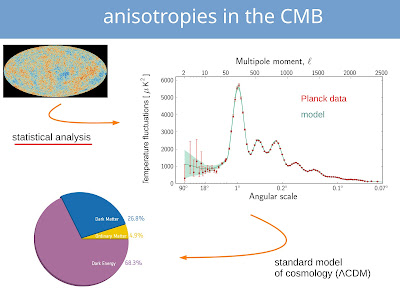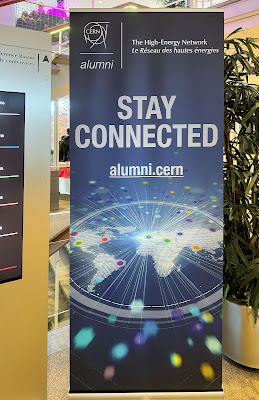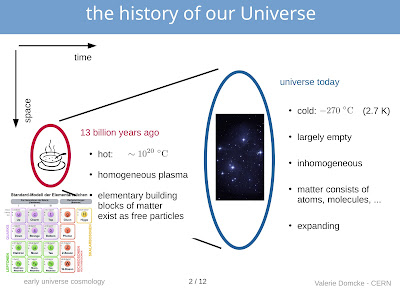Possibly, no one will remember my blog about the first alumni meeting, "First Collisions," at CERN in 2018.
The "Second Collisions" took place online in the fall of 2021 due to the coronavirus pandemic and the fourth wave of infection that swept through Germany.
Red Baron attended the "Third Collisions" at CERN from February 9 to 11, 2024.
Rachel Bray, the head of the CERN Alumni Network, opened the meeting at the Science Gateway, the new premises.
CERN's Director General Fabiola Gianotti, still the same, greeted the primarily young participants. Red Baron would not exclude that he was the oldest alumni present. I didn't meet any of my former colleagues and felt somewhat lost.
The excellent scientific contributions presented during the meeting mitigated
my dark sentiments. I shall pick some highlights and things that impressed me.
Rachel Bray, the head of the CERN Alumni Network, opened the meeting at the Science Gateway, the new premises.
CERN's Director General Fabiola Gianotti, still the same, greeted the primarily young participants. Red Baron would not exclude that he was the oldest alumni present. I didn't meet any of my former colleagues and felt somewhat lost.

|
|
CERN took about 800 photos of the young participants, i.e., Red
Baron was on only two. Detect the lonely old white-haired man in the third row of the Science Gateway auditorium (©CERN). |

|
| Here is another lecture hall with me in the front, my white head sticking out |
Professor Patrick Glauner from the Deggendorf Institute of Technology spoke about "The AI Revolution: Recent Developments, Opportunities, and Best Practices." He allayed his listeners' fears of AI, a technique that has long since found its way into everyday life. Legislators are currently struggling with regulations to limit possible excesses. Without knowing where the development of AI will eventually lead, this task is not easy.
In David Townsend's lecture "Medical Imaging Revolutionizing Healthcare," Red
Baron saw a photo of Professor Alfred Donath, who for many years was the
Geneva cantonal representative for radiation protection and also the
responsible supervisor for CERN. I have fond memories of him. R.I.P.
In his lecture "Physics, Facts and Frontiers of Climate Change Science," Jonathan Gregory once again presented the Standard Model to his audience. He showed a photomontage of the FCC, the future planned proton collider in the Geneva area.
Then Jonathan stuck to his topic and showed that "it is unequivocal that human influence has warmed the climate," emitting CO2 in the atmosphere.

|
| Future rise of CO2 concentrations following various assumptions |

|
| For him, as a scientist, it is vital to reduce the uncertainties of the various models |
Each session was preceded by detailed safety instructions. Strangely enough, was the radiation warning sign mutilated accidentally or intentionally?
I passed the illuminated CERN globe on my way to the conference dinner.
An alphorn trio greeted the participants at the entrance to the restaurant.
Valerie Domcke of CERN led us through "The Early Universe as a Particle
Physics Laboratory."
After the Big Bang, the universe cooled down to such an extent that it became "transparent." However, there are slight variations in temperature on the micro-Kelvin scale.
This allowed the cosmic microwave background (CMB) to be used to explore the
universe.

|
"The discovery of the CMB revolutionized our understanding of the universe. What surprises do gravitational waves have for us?"
In the session on Aviation & Space, "Beyond the Collider: CERN Alumni
Soaring in Aviation and Space," two contributions did not quite fit the
title but were enjoyable.
Thomas Rognmo of Nordic Electrofuel AS presented a plant for producing green fuel that already operates in Norway. The electricity exporter in Europe's north can carry out such experiments, even if their product cannot be made at the cost of fossil fuels and will probably not be competitive in the future.
Hannah Rana of Harvard University showed the Black Hole Explorer (BHEX) plans. Everyone has seen the glowing photon ring of a black hole in the press. The BHEX placed deep in space will, they hope, lead to a sharper image.

|
| For how long still? |

|
| Thank you, Pasquale |
*















Thank you for such a fascinating blog post about Third Collisions, it was an absolute pleasure seeing you over the weekend and I look forward to welcoming you back to CERN sometime soon! Rachel
ReplyDeleteThank you Manfred for adding the selfie. It has been great to chat with you. See you at the next collision! Pasquale
ReplyDelete